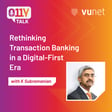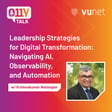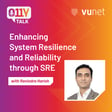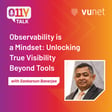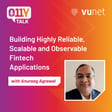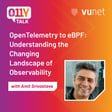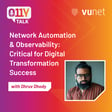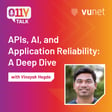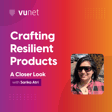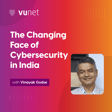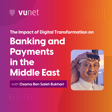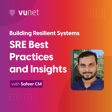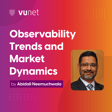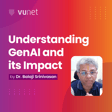Become a Creator today!Start creating today - Share your story with the world!
Start for free
00:00:00
00:00:01

Episode 8 : Redefining Observability and Trust in a Digital First World
Building citizen scale systems goes beyond technology and is about delivering trust, reliability, and seamless experiences across organizational boundaries.
In our latest episode, we are joined by Vamsi Madhav, CEO of Finvu and ex-COO & Founding Team member of DigiSahamati Foundation, who opens for us the foundational elements of building citizen-scale systems. Beyond talking about the underlying challenges, he explains the account aggregator framework, why Root Cause Analysis (RCA) and "Availability when you need" are crucial when evaluating Observability platforms, and how Observability has become a talking point in board rooms.
Transcript
Architectural Choices & System Reliability
00:00:00
Speaker
So I think this has become a foundational element today that people on the building side have to be very conversant with architectural choices that have to be made. And a third element in the last few years of my experience, Sarmati and now Finview, the interesting definition of scale is actually reliability across organizational borders.
00:00:25
Speaker
I mean, in the first and the second, it was still largely closed-loop systems. You're building systems which reside within a certain domain of an object. add press to your building some integrations with a few other parties. But now internet style delivery of service has become the norm. And you know, in the Sahamati experience that I had and what's happening, like you said, in India's financial infrastructural transformation, you know, digital public infrastructure has basically made it mandatory that every transaction
00:01:01
Speaker
is architected or designed as a cross border, so to speak, transaction, right? Where ah in one single transaction, I will have to actually seamlessly transcend boundaries of maybe five organizations, right? And it has to be reliable across those boundaries. So I think reliability, you know, internet style, you know an internet style for me means as a user, I frankly don't know how this website is delivering whatever is delivering. I don't know where it's going.
00:01:31
Speaker
But that is a very key foundation element.
Introduction to Vamsi Madhar & His Experiences
00:01:48
Speaker
Welcome to a new episode of Observability Talk. Our guest today is Vamsi Madhar. Vamsi is the CEO of FinView, a RBI licensed and NBFC account aggregator.
00:02:01
Speaker
Before he went into this entrepreneurial journey, he was the Chief Operating Officer of Sahamati, working towards setting up an open banking ecosystem in India. He has over two decades of experience and has worked in organizations like Mahindra Commviva, Vsoft Technologies and OneMoney.
00:02:19
Speaker
In this episode, I am excited to talk to Vamsee on his journey and we will deep dive on his perspective on digital transformation, customer experience, the role of observability when formulating a business strategy and perhaps one of my favorite topic of exploration is observability becoming a meeting agenda in boardroom conversations. Thank you so much Vamsee for joining us today on observability talk podcast.
00:02:49
Speaker
Thank you, Bharat. Always been a pleasure and it's a privilege ah being given this opportunity.
00:02:58
Speaker
Vamsi, India is witnessing a groundbreaking innovation in the financial services. and You have been closely involved in building certain citizen scale platforms like at Mahindra, Conviva, Samathi and now at Finview. It would be fantastic to get your perspective on these foundational elements ah in building systems at scale.
00:03:22
Speaker
The question but it actually has been quite thought-provoking for me, frankly, because it sort of forced me to go back and frame my experience um as a builder. ah and you know My background just for your audience is, i I have been in the tech industry, ah but I have not built tech the way traditional ah you know definitions of that would mean. I have ah been on the business side and on the product side. I was a business analyst to begin with. I learned a lot of technology jargon and concepts from ah much more erudite friends of mine.
00:04:07
Speaker
and always enjoyed discussing the concept of scale. Of course, over the years, having been in product companies, one then becomes obliged to deliver scale ah in terms of metrics that business folks at the other end measure. So it was interesting for me to figure out What would the foundational elements be reflecting on those? And I perhaps you know would like to frame it as three different ah definitions of scale that I personally experienced.
Building Resilient & Available Systems
00:04:44
Speaker
In the initial days of my career, scale meant resilience to time. ah So we would build ah systems, let's say, for banks.
00:04:56
Speaker
and you know what One would have to build is that if the people building it changed, the team members changed, everything that's loaded in had to be maintainable. So maintainability was sort of a keyword and you had to be resilient to the changes that time brings about in who's building it.
00:05:20
Speaker
i This was the pre Mahindra Conviva, so I used to work for a company called Vsoft where we built a lot of systems for financial institutions in the US and in India and so on. At Conviva, I really saw a new definition of scale which was to do with the building for availability.
00:05:42
Speaker
Mahindra Kombiva's products that I was a part of building was to build mobile wallet systems that were deployed in over 70 countries and I think ah the largest telecom companies in each country would be the users and usage patterns and seasonalities would suddenly become the new problem to be resilient to.
00:06:10
Speaker
And the foundational element here, unlike the first part where maintainability meant really good design as a foundational element, right? I mean, first principles of oops, you know, being very modular in how you think, getting relationships right, those were sort of critical success factors.
00:06:33
Speaker
But when it came to the foundational element of building resilience to usage behavior and volume and variety of usage patterns, Architectural decisions became a foundational element. So at this time was the era of microservices architecture becoming the key thing. ah you know The cloud was suddenly the new fancy shining object, ah you know concepts like auto scale and being cloud native. So I think this has become a foundational element today that people on the building side have to be very conversant with architectural choices that have to be made.
00:07:10
Speaker
And the third element in the last few years of my experience, Sarmati and now Finview, the interesting definition of scale is actually reliability across organizational borders. I mean, in in the first and the second, it was still largely closed-loop systems, your building systems which reside within a certain domain of an organization.
00:07:35
Speaker
At best, you are building some integrations with a few other parties. But now, internet-style delivery of services has become the norm. In the Sahamati experience that I had and what's happening, like you said, in India's financial infrastructural transformation,
00:07:55
Speaker
you
User Expectations & System Design
00:07:56
Speaker
know, digital public infrastructure has basically made it mandatory that every transaction is architected or designed as a cross border, so to speak, transaction, right? Where ah in one single transaction, I will have to actually seamlessly transcend boundaries of maybe five organizations, right?
00:08:16
Speaker
And it has to be reliable across those boundaries. So I think reliability in an internet style for me means as a user, I frankly don't know how this website is delivering whatever is delivering. I don't know where it's going.
00:08:31
Speaker
But that is a very key foundational element. So I think in summary, Bharath, to your question, as I reflected, um I think the foundational elements for builders now more than ever are actually a combination of all three. You've got to build systems that are highly maintainable, that are highly available, and now highly reliable across organization bodies.
00:08:55
Speaker
No, very, very true. I mean, these are something which has been ah the the mantra for ah somebody who is building large distributed systems. site I mean, um some of these things are like forever. writeio Whenever you want to build something which is really large, which is something very useful, you have to make sure that it is modular, maintainable, available, reliable, um and resilient is what ah you mentioned, read the first one, which was very, very important.
00:09:25
Speaker
One other thing, I just want to extend this to further. When you say reliable or ah available, are you also looking at it more from a customer perspective? ah When you say reliability or availability from which gives them much more, let's say a trust, a better user experience and make sure that they are fully confident that yes, when they did the transaction,
00:09:51
Speaker
It will definitely go through. So are you connecting these two parts ah using these words? Absolutely. In fact, I think the shift that I have experienced and continue to experience is to your point, these evergreen problems were always problems for builders.
00:10:10
Speaker
but consumers were largely in a world where the consumption of the service was maybe physical, you know with the digital being in the back office, or at best, digital with you know part physical, part digital. Some of these you know elements were not direct expectations of consumers in the past. But now, right ah with everything becoming digital first,
00:10:40
Speaker
um I think what we are seeing both as consumers ourselves that our tolerance and patience for ah you know latency problems in how our service is delivered to us is going down by the day. right I mean, yeah it's a very funny thing that on the one hand, we actually have the power of not shifting from the chair that I am in and getting everything delivered to me. So you know how much convenience can one want?
00:11:08
Speaker
On the other hand, I am actually far less patient when I'm consuming things digitally than if I'm forced to go and stand in line somewhere. i mean And so I think to your point,
00:11:20
Speaker
Availability um and the lack of it, you know my propensity to shut down an app if it takes more than a few seconds to be available. Or if it is not available to me at the time when I want it, it could be midnight, it could be early morning when I'm driving to the airport. I need all systems to be highly available and you know very little latency.
00:11:49
Speaker
And so I think these are sort of first principles now in terms of how we define consumer expectations, absolutely. Right, right ah so if you look at right that you you talked about that you have been working on software product from different ah angles and different set of people and you have developed certain products for a BFSI and fintech vertical and somewhere you have a unique view of how digital transformation affects customer experience, the thing which you just talked about. um up You have seen other companies also
00:12:28
Speaker
getting into this journey of digital transformation. right So ah what do you think are the key elements for some of these enterprises or companies to get this right ah to meet the evolving expectations of today's customers, like you said, right that ah we are becoming very impatient. ah India, in fact, I was reading a report, I was saying that we are the most young country in the world today.
00:12:56
Speaker
ah who have access to mobile as well as ah digital ah payment applications and so on. So so what what sort of ah things or key elements these ah enterprises have to get right to to make sure that they are able to meet the evolving expectations of today's customers.
Challenges in Digital Business & Tech Decisions
00:13:19
Speaker
Firstly, Bharat, let me perhaps for the sake of your audience um you know describe where my viewpoint um has been formed from because you know it's easy to have opinions without having a lot of relevant experience these days. ah yeah like The last five years to your point, um I've had the unique opportunity perhaps of actually talking to ah literally really hundreds of financial service providing institutions i hasn't um and I think that observation of how the modern
00:13:56
Speaker
community of builders is looking at things is what is going to drive whatever I say now not so much what's happened in the past where we were all building you know technology as part of kitchens that were yeah you know very close than talking to an individual buyers at the other end. I think there are broadly what I am seeing Bharat is that three things have to typically come together and two of those are where I think differentiation today lies for building unique digital first businesses. I think the hardest thing increasingly which is becoming harder by the day is getting the the view as to who the targeted user and buyer is. I think research, I mean with digital it's actually fairly easy to build a business where the definition of building is
00:14:50
Speaker
just having something launched. I mean, today, the ability to copy fast a feature that somebody else has built and engineer something that is good enough for a few people is easy. But to build a sustainable digital first business, I'm seeing increasingly many people becoming smarter and more in the loan product market fitment in terms of finding the right problem and the right persona to chase.
00:15:17
Speaker
because that's very subjective. It is almost very artistic and very you know sort of um ah qualitative in terms of a decision that the business makes. this This is part one, deciding who the user is and what problem is to be solved. And the reason I say that is I think we still see a lot of businesses and builders wanting to build everything for everyone simply because they don't know where the right monetization for them will be and that always sort of becomes a problem. On the other hand, I've come across several you know ah smart savvy builders that I'm envious of because they have the ability to say no and they say no, I will only do this and I'm very clear as to why and so that's sort of critical. The second part is where we see a lot of activity and unfortunately this is becoming commoditized which is the whole
00:16:11
Speaker
development and DevOps activity of building a feature, iterating on UX, building workflows. Yes, there is a lot of work to be done here to get stuff right and observability in terms of iterating fast on this element. You know you roll out a feature, do you have enough observability in place to see what's happening?
00:16:38
Speaker
and And in a digital world, unlike physical, gathering this feedback can be quite hard if you haven't engineered for it. i mean And we still find a lot of businesses that claim to be digital first. um you know I have the problem too as a builder still, where we haven't yet engineered observability natively into our building of products features. But this is relatively easy to do.
00:17:05
Speaker
The third element which I think is where there is still a lot of darkness for the rest of the world and consumers is where magic happens, which is the engineering side of things. right There are decisions taken in terms of very deep tech that is driving a lot of the magic that consumers see, the simplicity and those engineering decisions in terms of architecture design and a lot of the observability and non-functional it is ah being engineered.
00:17:36
Speaker
are where I'm seeing some businesses and teams really do a ah great job. And I think in the last decade, we've seen success stories out of the consumer internet companies that have really scaled up. right I mean, in India, there are so many. Globally, there are so many. We are seeing a lot of their best practices becoming native to how builders of today are thinking about. And so I think those three elements have to come together.
00:18:03
Speaker
No, I think you one thing I straightforward want to ask you post this and description of whatever you said. right um Looks like most of the people have this observability as an afterthought. is If I say this statement, is it ah what would you say? Is it true or false or some somewhere in between?
00:18:25
Speaker
hundred percent i think I think people realize the ah the lack of it more than they appreciate the need for it. And therefore and and they always realize the lack of it when they are hit by a problem.
00:18:44
Speaker
ah and And then everybody goes slapping the back of their heads or other people's heads saying, oh, we should i have had this almost, and like you very correctly said, it's an afterthought and um you know people realize the need for it. but ah I really think that we are now at a point, and and I know later in the conversation you will sort of touch upon it, we are now at a point where this realization is coming front and center in transitions, but largely it has been an afterthought.
00:19:17
Speaker
Okay. Okay. ah Thank you so much, Vamsi, for those insights.
Account Aggregator Framework & Sahamati's Role
00:19:21
Speaker
Vamsi, you have done amazing amount of work at Samathi, enabling adoption of account aggregator framework for financial inclusion. And it has been very inspiring. When I met you first, ah when you were part of Samathi, and we were very excited about how this whole account aggregator concept will change the face of ah ah how people take loans and how they will be able to ah ah get these things going. In fact, i when I applied for loans some time back, I could actually do that through Perfios account aggregator. right ah I just want you to take maybe
00:19:58
Speaker
30 seconds and explain this concept because ah what we have realized when I talk to people, what we have realized is that there are still a lot of people who do not fully understand ah what this account aggregator framework is about and how it will basically be helping ah people.
00:20:18
Speaker
Bharat, I think um know you're absolutely right that this um is not something that has yet touched the awareness levels that we wish it had. So I will try my best. 30 seconds is ah is a tough timeline, but I'll try my best to explain it. I think the easiest way that ah perhaps consumers would understand, like you said, is each one of us perhaps at some point does take a loan or does seek advice from maybe our investment advisors or our chartered accountants and at some point in that sort of conversation we are asked either our bank statement or a statement of where our investments currently lie and
00:21:08
Speaker
that microtransaction in the whole conversation that we have usually becomes the longest ah activity in that transaction.
00:21:19
Speaker
because I will then say, oh wait, I will have to go to my net banking application and download my statement, I'll do it over the weekend. Or I say, oh, you want my holdings information, let me sit down with my wife and over the weekend figure out where we have, what all we have and then I'll give it. So this act of actually giving one's financial information to a potential lender or a potential advisor,
00:21:44
Speaker
actually has ramifications that are not seen. And those ramifications are, I may just drop off from the whole conversation. I may decide to go to suboptimal you know options which are maybe higher priced and not the best offers but simply because somebody is coming home and either forcing me to give the information right then and there and they just end up you know giving that information to that person. So the act of gathering and sharing information actually has become
00:22:18
Speaker
a problem over the years, both for consumers and even more so for the lenders and the advisors. So a account aggregator has tried to bring together a digital solution to this problem.
00:22:31
Speaker
And much like how identity verification has been solved by Adhar over the years, and how payment transactions has been so brilliantly solved by UPI over the years, the act of me being able to give my bank statement, but just like I give my money ah digitally to somebody else who wants it,
00:22:53
Speaker
is what a account aggregator is and the central term that really is a better descriptor ah than even the term account aggregator is consent manager.
00:23:05
Speaker
because I think what is central to this and what we as account aggregators do, I represent one of India's leading account aggregators called Finview account aggregator, one of the earliest. And we are trying to be what I call India's most reliable account aggregator. By the way, reliability is a keyword that we have adopted. And I know you will perhaps like it given your focus on observability.
00:23:34
Speaker
ah So, what we do is we provide interfaces to citizens to give consent and we then act as plumbers connecting the citizens banks and wherever else the citizens data may lie.
00:23:52
Speaker
to the destinations that the citizen wants the data to go, which could be other banks, lenders that are NBFCs, investment advisors under SEBI. And so there is a network today of about 500 plus institutions that the thanks to the efforts of the Sahamati community. And by the way, you know while you you credited me very kindly, I must say that all the effort has been actually of Players like yourselves, the technology vendors, the financial institutions, ah who brought together implementations, right? And of course, the regulators, because the regulators way back in 2016 laid the rails in terms of the specifications and the master directions. So, you know, we've just put our shoulders to the wheel, but the point is that citizens today, over 100 million of them have successfully used this rail
00:24:47
Speaker
to conduct that microtransaction. So, you know, like you said, you went for a loan and you were able to use Perfios to do that. Similarly, you know, millions of citizens over 20 million of them on our platform actually use Finview A to conduct that microtransaction of giving their data, be it a bank statement, be it, you know, their team at account statement or their mutual funds or what happened. So that's what a account aggregator does as a concept.
00:25:17
Speaker
That's very interesting. I mean, I think ah most of the people will listen to this podcast only to understand account aggregator what it does and how it really does that. Right. Thank you so much. ah One of the things which we were discussing when we were were working together at Sam with the right one of the biggest challenge ah you had or you had to overcome was ah having a trust ah ah based user experience because as you rightly said that people are a little finicky about giving their account information
00:25:51
Speaker
or sharing their account details or account statement and so on. right but so So you had to do certain things to make sure that people trust the system or you sort of give such sort of a ah user experience for that. What are the steps ah you took to overcome this challenge? eight And my question is again a little ah ah more self for this thing that does real time monitoring and visibility have had any role in this?
Trust & Transparency in Multi-Organization Systems
00:26:22
Speaker
So Bharat, your audience deserves to know the the great work that I think the ViewNet did, thanks to the discussions that we had, ah because there was a real problem and it continues to be. Of course, the problem is not solved and you know we we need to keep chipping away at it. The problem is actually a consequence of what we said at the start. i mean today the transaction crosses boundaries of organizational domains. But trust doesn't easily cross those boundaries. I mean, you went to take a loan, you perhaps fundamentally trust the bank where you've kept your money for several years. yeah right ah You perhaps trust the lender, and which is why you're going to the lender in the first place. But in between, there are these new kids on the block called an account aggregator that you perhaps don't even know of.
00:27:19
Speaker
And, you know, then unknown to you, maybe a few other parties, ah maybe there is a Sahamati that nobody knows of in the consumer world by design, but they do have a role to play in terms of offering, ah you know, some meta information for the transaction to go through. and So the problem is that today, expectations of consumers are that everything will happen in a GFI.
00:27:46
Speaker
but that everything should happen crossing transactional boundaries ah that organizational domains ah you know have. right and What I have realized is that whether it is builders or consumers, while we may be impatient with respect to latency,
00:28:07
Speaker
We are actually even more impatient if there is no transparency of why something is going wrong, if it is going wrong. right So what we attempted to solve ah you know with the your help was bringing transparency first, which is basically to say can each of the organizations that is involved in the fulfillment right have a transparent of where a certain transaction is in terms of the metrics that are relevant. right The response time of a certain API call, ah the error codes or the success codes that the API call resulted in in the systems,
00:28:58
Speaker
and break it all together in a format that can be consumed first by the builders in the network and then ultimately by consumers themselves who are using those front-end interfaces that the builders are offering.
00:29:12
Speaker
so I think what was very critical and even more so because of this distributed sort of transaction fulfillment ecosystem is that we need to have transparency as a first solution. i mean Once we make transparency a value, I think everybody is highly technically competent to solve their respective ends of the problem.
00:29:34
Speaker
the issue was and continues to be that people say, I don't really know what the problem is. Forget you know what the solution is. I don't even know what the problem is. right kind of And so that's what we attempt to solve. And I think we became a certain distance, ah but much more is to be done.
00:29:52
Speaker
I completely agree because ah today also when we talk to a lot of our banking customers, right one of the biggest challenge they see with their end customer is ah if it starts buffering or if it starts taking more time, the end customer's transaction.
00:30:09
Speaker
ah People are generally, like you said, right that people are impatient. So they are trying to maybe click on buttons, cancel, oh, it is not going and what will happen to my money and all sorts of things. right And if ah banks become more transparent by giving them very quick view in terms of whether it really happened or not happened.
00:30:27
Speaker
and their money is saved and so on. right ah ah It will automatically build trust right like ah perhaps what what you were trying to say. So that I think is ah one of the main reason why people at least the enterprises which we are working with also have started doing observability more from the business perspective.
00:30:47
Speaker
ah bringing in more transaction level view rather than looking at more machinic view as in my server is doing good or my application is doing good. More than that people have now started moving towards how my transaction transactions are doing.
00:31:03
Speaker
are they feeling, where they are feeling, ah is my ah customer getting impacted and so on. got it Now, ah if you look at it from BFSI perspective, right one of the things which we have been told by a lot of our customers that there are a lot of regulations right and there are a lot of compliances which ah each of these enterprises, whether it is a startup or whether it is a FinTech or whether it is a NBFC and so on, that they need to ah make sure that they comply too. In this highly regulated sort of compliance driven industry, how do you see observability aligning with compliance and this regulatory requirements?
Observability in BFSI: Alignment & Expectations
00:31:44
Speaker
just to Just to add to this, ah we have been told by a lot of our banking customers at least that ah RBI mandates to ah ah in certain set of applications that ah then should be ah you should keep the transaction data for X number of years. right So I am and bringing it this question from that side and what what is your views around this.
00:32:08
Speaker
I think Finview AA, as you know, is an NBFC. and i'm you know In this role, I'm obviously experiencing ah a more direct um sort of influence of regulations on our business. and I think ah my sense is that you know over the years whenever any of us participated in audits, that dreaded word, I think the ah most significant item that we would always be asked to present was evidence of a certain process being followed.
00:32:45
Speaker
right i think now That is again becoming front and center because in the digital world and with RBI so strongly promoting various kinds of digital ecosystems, evidence of cybersecurity norms being followed, and or evidence of um grievance redressal systems in a digital world being highly available and highly functional. um and Evidence of data privacy, rights of citizens being respected through, ah you know, logs of
00:33:29
Speaker
who is accessing what item of information in which system. I think this has just sort of, I would say, magnified in terms of importance in today's work. And so we are seeing this that ah there are regulatory reportings that each one of us has to do. um And it is increasingly becoming more granular. The the information sought, ah the monitoring that we are expected to do is increasingly becoming more and more granular. And so to your point about retention of data,
00:34:10
Speaker
ah I think, and this is a thought that just struck me, you know our our email servers have sort of mastered the art of retention of data ah about a decade ago. In the initial days, we would all be subject to certain you know constraints of how long. Today, it's just ah always available and I can always go back right to whatever.
00:34:33
Speaker
so i think We perhaps have to be prepared for ah using the best the technology has to offer. Storage costs are going down. We can no longer complain about costs. um you know Observability systems are becoming more and more modern and we should speak a little bit about that. ah The regulatory needs therefore can no longer be brushed off as cannot do. right I mean, we will have to now do it.
00:35:01
Speaker
Because increasingly, as you well know, the latest flavor of of this season is fraud. And in the digital world, I think ah we are seeing, we ourselves, I must say that a lot of my time now, Bharat in this role is actually going in investigating grievances that come and I am only one part of a multi-domain transaction, right? I mean, in fact, in many ways, our role is far limited because we are a data-blind digital career company, if you will. But we have to respond like our regulators would want us to respond. We are regulated in order to protect the interests of the citizen. So a lot of my time goes in investigating through logs
00:35:52
Speaker
What is exactly happening for a certain consumer? consumer What has happened? And I cannot ah put boundaries of time there. I can't say, okay, this was six months ago, so I don't know. right So we will have to do far more smarter logging. We will have to do retention of data for as much time as is required by the citizen, not even the regulator. And of course, there will be some practical limitations, but you know increasingly ah those are becoming only oriented towards more time and not less time, right? You will have to sort of, like you said, RBI says seven years. I mean, somebody may question saying why, why not even longer than that? And so, hey um I think this is absolutely critical even more now for regulated entities and even unregulated entities because the outsourcing norms
00:36:48
Speaker
from RBI for technology vendors are becoming you know even sharper and clearer than they were before. So, it is absolutely critical for everybody. No, I think one thing I also felt where the way you describe this right it looks like this will also help uh, citizens or end users, much more confident in the system. That is one of the reason why these regulations, compliances are put in place, right? So so that as are RBI or regulators can actually give more confidence to the user that his or her transactions, money, or whatever else it is, right? Information is being used in the right way. Right. So I think, I think just to add to that, uh,
00:37:36
Speaker
Consumers themselves are demanding such history and you know evidence of of us having recorded who's done what because ah they also want to trust at the same time because of fraud. Everybody is wary.
00:38:00
Speaker
of whether they are being ah ah you know sort of gamed by someone. right So consumers are demanding proof and evidence and support ah reliability.
00:38:14
Speaker
And in our business, just to sort of amplify the point, a lot of my time is going actually in internal systems that we have, and because our support team depends on those systems being easy to use.
00:38:29
Speaker
ah Because when a consumer comes to our support channels, and increasingly we all have real-time support channels. right Email is ah is an async channel, but many of us have WhatsApp. And so again, support has become a low latency expectation. I ask a question, I need an answer right now. and So our support team needs highly available log systems, which are easily queryable, which are easily usable.
00:38:56
Speaker
And those have to give information that can be framed back in terms the consumer can understand. So I think ah regulators are demanding, as you very correctly said, because consumers are demanding, and it is necessary to build trust at scale, 100%.
00:39:11
Speaker
right right oh Just i but taking the same point further, ah we talked about that systems are becoming modern. hit And ah the modern systems would require a modern approach ah to observability. eight
Choosing Observability Platforms for Fintech
00:39:26
Speaker
um And you seems to have been working on these citizen scale systems it in the past. um If you are going to choose an observability system or a platform, what would be your key expectations from it?
00:39:42
Speaker
Three expectations Bharat, having thought through this thanks to your question prior to this. I think the hardest problem today is root cause analysis. It always has been hard and in a distributed system it is even harder. So a modern system that is able to actually you know make that hard problem simple.
00:40:05
Speaker
by By crashing the time it takes to isolate which was the weakest link in the chain would be the first, you know, system expectation. The second is I think the presentation of an actionable metric.
00:40:23
Speaker
I think a lot of systems throw a lot of information, but then it is left to humans in the loop to figure out which of these is the real actionable metric and which of these isn't.
00:40:34
Speaker
right and so i think systems that are able to ah sort of acquire the intelligence of what is the decision maker wanting because in most cases the action is to be taken by someone who understands more of the pain point of the consumer but not so much technology, right? ed And so while you will always have the the tech folks available to make sense you know, decision times have to be crashed. And so systems that are able to abstract out a lot of the complexity and isolate not only the root cause system, but the root cause metric that has to be action, that would be number two. And I think the number three system is that the yeah the observability system has to be available to me when I want it, ah not not available for me to go to
00:41:29
Speaker
either different place What I mean by that is a very friendly and highly available observability system is required because you know I have had situations where ah somebody has woken me up you know, outside office hours, either early in the morning or later because consumers are using it all the time. And, right and you know, we promise ah four nines and we promise all kinds of SLAs in our business, but our so our systems are still not geared towards that sort of high availability.
00:42:01
Speaker
And when the when the grievance is there and we need to respond, it is the observability system, the modern the observability system that has to suddenly become the most intelligent, highly available system. So alerting systems, being able to push alerts in channels that I am on, right? Just like we push our services to channels that consumers are on.
00:42:26
Speaker
ah whether it's WhatsApp or whatever. So I think a highly friendly, highly available system in terms of distribution of that actionable metric is sort of the third key criteria. Those would be my criteria. Thank you so much. I think somebody would have asked me ah what BUNET does. I might have ah at least mentioned all three of them, which you've mentioned. right ah And in the IT operations world, if you look at RCA or probable RCA is sort of a holy grail. hey Everybody is trying to figure out how do we provide a sort of probable RCA or final RCA if they can ah for any problems which are happening in the system. right So I think you are bang on from the three. The only last point which I will add, which I was talking about ah sometime back
00:43:17
Speaker
People have started, at least the customers whom we have talked to, have started talking about the business context part. absolutely ah ah The monitoring platforms used to be quite horizontal in nature. and They basically will give you a lot more machinic information like, okay, CPU utilization is high, or disk utilization is high, or my DB is having slow queries and all.
00:43:40
Speaker
but they do not up attach it to a business context. So kidding in in today's environment, at least the information which our customers are giving us, they are saying, no, no, no, they are looking at ah business observability, ah not only the monitoring device.
00:43:58
Speaker
right and you know Just to amplify your point and and perhaps reiterate the actionable metric for the decision maker. Like I said, you know the decision maker ah is someone who understands the consumer world, not so much the technology. and So the actionable metric has to be presented in those terms.
00:44:19
Speaker
Which is, I think, saying the same thing that you were a little differently because the metric is no longer, hey, what is the CPU usage? The metric is ah something that is maybe in terms of hours latency, you know, deteriorated in the last 30 minutes, right? Exactly. What is the consumer experience metric that we should look at? So, like fully in alignment that A modern system has to speak the language of decision makers, not the internal builders and it has to make it available to decision makers ah in quick time so that they are able to take action. yeah Just taking this little further again, um now that we have defined what we expect from an observability system or platform, um in in your current role or in your previous roles, would you
00:45:15
Speaker
try building an observability platform yourself, or would you prefer buying it from ah an OEM vendor? ah And what will basically ah what what sort of points will basically move you from one direction to another? Yeah, I mean, that's a great question. I suppose you know there's no one size fits all to that um because decisions of build versus buy come from various angles. But you know let me give you my thought, given my context. right I think yeah um you increasingly,
00:45:50
Speaker
we are oh being pushed to spend most of our time on what drives our revenue or what drives our you know sort of oh business goals. right And increasingly, I think in the world that we are in, which is loosely what we can term as FinTech,
00:46:10
Speaker
I am seeing that getting sharper on on ah acquiring customers and in the enterprise B2B fintech world that I inhabit, um I think you know finding out the motivations for ah the buyers oh who buy enterprise software or who sign up services like ours, engaging with them to co-create use cases, engaging with them to understand their revenue drivers and monetization drivers is where I should be spending more of kind you know our team's time in. So if in that sense,
00:46:57
Speaker
um you know, we don't get paid for building the best observability system ourselves, right? we will yeah it's ah It's a means to our end. So perhaps in our case, we will look for best in class systems that do this and you know, because these are costs that we must incur so that we can actually deliver value ah and we spend more of our time in in what we can be uniquely different vis-a-vis our peers and our competitors.
00:47:28
Speaker
So in our case, we will perhaps look to getting expertise from outside. But there are certain things that we would still want because we are a tech team ourselves. A lot of intake is also, there are some core assets, for example, that even from a regulatory standpoint, we should entirely own. It's a risk.
00:47:52
Speaker
ah from a regulation perspective to outsource anything that's core in terms of our activity. So, for example, the activity of consent management and the activity of allowing sharing of data through the rails that follow the protocol that the regulator has read out.
00:48:07
Speaker
that tech we own. And so the observability of the core elements of what we build, ah significant parts of that we would still have to build in-house. ah But there are several pieces that we build ah over and above the core, ah whether it is in our front-end client interfaces where a lot of the because consumer experience is actually there. you know the The analytics that help us refine user experience is entirely left by regulators as an innovation topic. And so there we may want to build best in class or rather in source from experts such as yourselves, observability systems that help a lot of that. So right that that would be how I look at it. well Right. no so So this is something which we have been also talking to a lot of our customers, though our customers are little larger banks and so on. And they do have their tech team.
00:49:05
Speaker
ah One other the thing, what we have been telling them is that their data part, maybe they need to make it ah much more internal, that how do you collect the data. But once you send the data out, then you need a system which can actually correlate, contextualize the data which is coming in from X number of machines, maybe ah ah something which is not in your boundary also. I mean, get in your application boundary, maybe some other application ah it is talking to and so on. so that you can get a unified end-to-end picture. So that's what we generally talk about from that perspective. One of the interesting things which we have been, at least I've been talking to almost every host, every guest, which we basically bring into the podcast, ah because most of these people have been either on the boards or have been working with the boards in their roles. eight And I am very ah interested to know
00:50:02
Speaker
ah If and when ah the conversation around observability comes up in the boardrooms, ah does it ah come up often or is it like people have started talking about it now ah because of whatever ah things or challenges we discussed earlier? ah what have What is your experience around it?
00:50:24
Speaker
and I'm perhaps not um as experienced in in in that the sort of domain.
Observability's Role in Risk Management & Boardrooms
00:50:35
Speaker
um i am My experience is relatively recent, but what I do see is a couple of things. I think the lexicon in boardrooms has become far more technical than one would actually expect it to be. I mean, I think boardrooms, ah regardless of the background of board members, are all talking digital, are all talking API, are all talking experience of consumers. So I think boardrooms are becoming digital first in that sense as well. right need to um And therefore, um the second point, which is risk
00:51:14
Speaker
which is largely what boardrooms are concerned with. I mean, largely at least the conversations that I have been, a few conversations I've been a part of, we largely end up discussing, of course, growth strategies for the company as one component, but the second component component i immediately, particularly for regulated businesses like ours, is how are you dealing with risk? And it goes back to the point we discussed earlier, you know, recently i had a conversation with a board member of ours and the entire conversation was centered around How do we mitigate or how do we prevent risks that may stem from various sources? and Because we are in the business of handling data and we are in the digital sort of public infra business, all the elements you just said your big banks are talking to you about.
00:51:56
Speaker
where the conversation point, say what controls do we have in place, you know what the policies and procedures can we codify and and a lot of it is based on ah heightened sensitivity to you know, regulate reaction, right? And so investment in, it's it's never enough. I mean, investment in in the kinds of systems we're talking about, i it almost seems like it is never going to be enough. You have to keep yeah they pushing the boundary and every new incident that happens goes full circle back. We've got a report to our board
00:52:40
Speaker
and Not every incident, but consolidated list of incidents will happen. I mean, that's the requirement. yes And so we have to immediately prepare to answer their questions on how are we preventing it. And that takes us back to how are we strengthening observability, how are we strengthening in the support and so so on and so forth. So I do see that in our business, particularly mine,
00:53:00
Speaker
This will be 50% of the energy that we spend. and So that's very substantial for us. Very nice. Thank you so much for all these insights. One final question before I let you go. ah We generally ask every guest ah what are their favorite books that has really transformed and inspired ah them,
Philosophical Insights from 'Zen in the Art of Motorcycle Maintenance'
00:53:23
Speaker
right? ah If you can name one or two and how how did they inspired you?
00:53:29
Speaker
but There's only one that comes to mind ah because these days you know it's hard to sort of finish a book but you know much less. but i get this one There's one that that I actually ended up but finishing. It's a book called Zen in the Art of Motorcycle Maintenance.
00:53:49
Speaker
ah by an author called Robert Persig. and um you know I read it many years ago, couldn't finish it. and Then I picked it up but actually about a year ago and I was hooked to it. and i think ah It's a book that is very unique for me because it's on the one hand highly philosophical. On the other hand, it is highly driven by a notion of quality and yeah it's quite interesting the way the author brings about ah very intensely the notion of quality and and blends that with philosophy. so
00:54:31
Speaker
somewhat deep, I suppose the way I'm saying it, but it works for me. No, no, thank you so much, Vamsi. Thank you so much for your time and insights. and It has always been great pleasure talking to you. And thank you so much for coming on the podcast. The like ah the pleasure is ah likewise and mutual Bharat always enjoy talking to you Ashwin and the rest of the team. So looking forward to more conversations.
00:54:58
Speaker
Thank you. If you enjoyed today's episode, please consider sharing it with colleagues who have similar interest. It will help us spread the word. For more information about BUNET systems, visit us at www.bunetsystems.com.
